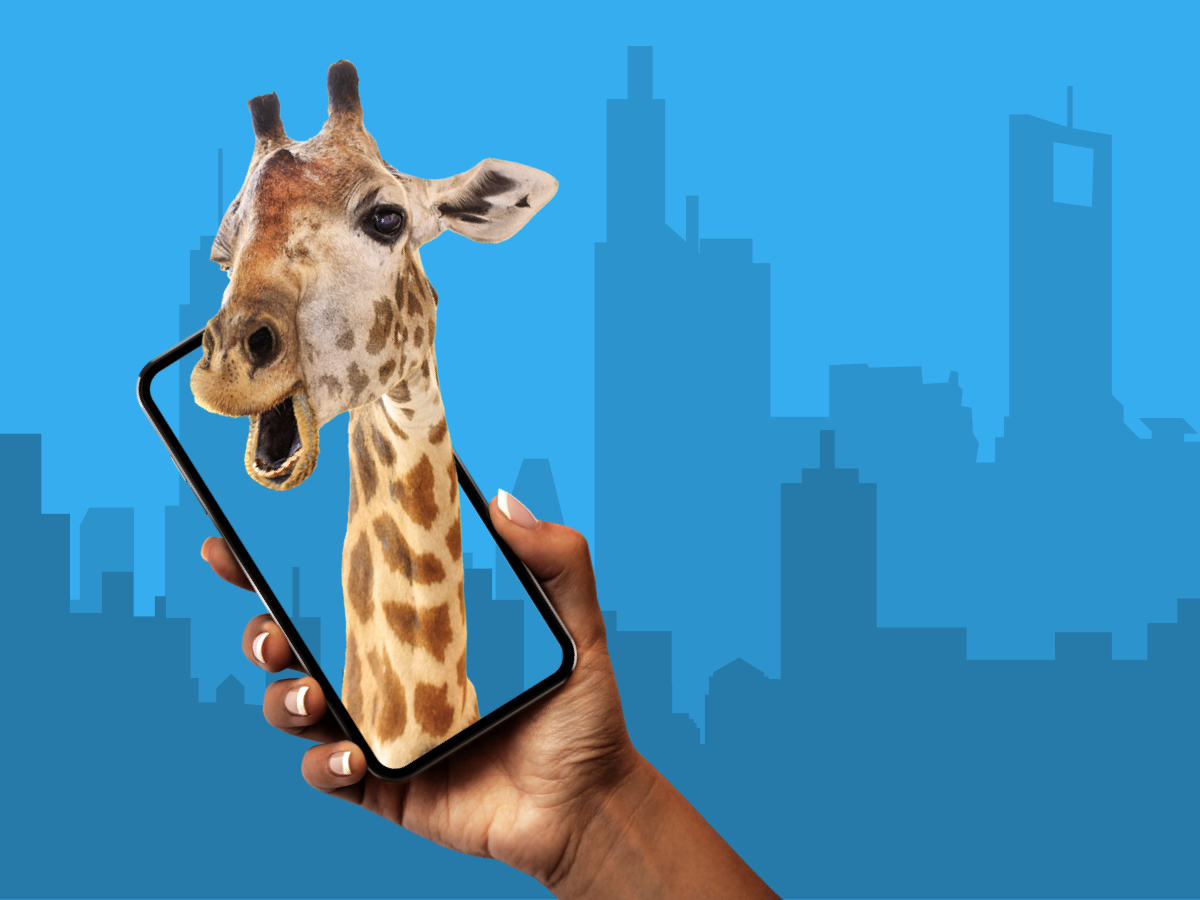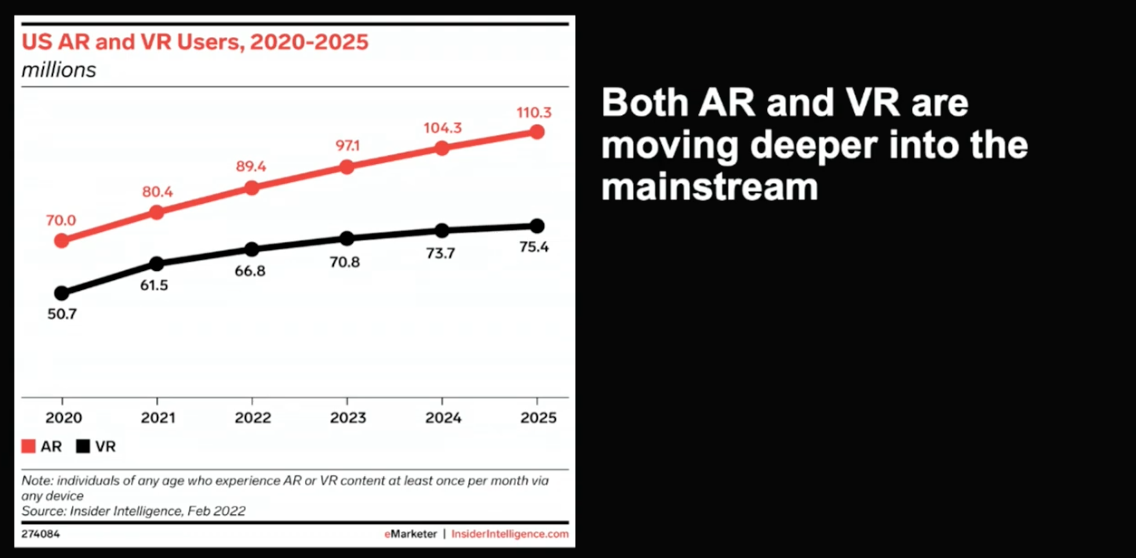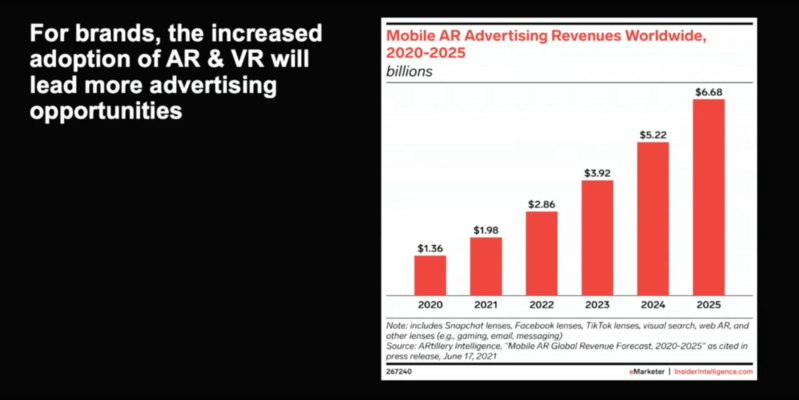Giving the Gift of Augmented Reality

Competition for consumer attention is at an all time high–and it’s not stopping anytime soon.
Just think about it. Right now you can watch Hulu on your Roku TV, doomscroll through Instagram and TikTok on your phone, or fire up your Nintendo Switch and recreate the halcyon days of spamming your friends as Kirby in Super Smash Bros.
With so many options for audiences to get their entertainment anywhere, at any time, right at their fingertips, how can brands divert some of that attention to their ads?
By giving their audiences a gift.
That’s how Hannah Blahut, Global Accounts Manager at QuickFrame, described the opportunity for companies to leverage Augmented Reality (AR) in branded advertising. She recently joined Insider Intelligence’s Yory Wurmser for a webinar where he revealed a new analysis report on Augmented and Virtual Reality (VR) trends in the United States. The discussion explored what’s driving consumer adoption of these unique video ad placements and how they are reshaping the ways brands use ad creative to interact with their audiences in the 21st century.
If you missed the webinar, you can still catch an on-demand recording to hear the complete session. But hey, we get it, you’ve got limited bandwidth. Let’s break down some of the key takeaways to give you a birds-eye view of what’s shaking in the world of Augmented and Virtual Reality.
What’s Driving AR/VR Adoption?
It’s safe to say that in 2022, AR and VR are moving into the mainstream. And no, it’s not because of the metaverse. Or, well, at least not entirely. Public interest in virtual and augmented reality can be traced back to the late 1970s and the emergence of the cyberpunk literary genre. But in recent years it’s traveled off the pages of paperback science fiction and into our everyday lives. The cause of this? Retail and social media.

Snapchat put augmented reality on the map with the introduction of their creatively engaging lenses that allowed users to transform their real world into a virtual one. But like everything else in Silicon Valley, once one brand was doing it, every brand was doing it. More and more social platforms have rolled out augmented reality experience tools to facilitate the growing popularity of these placements, repositioning AR from pure entertainment to a creative play for retail and eCommerce brands to grab audience’s eyes.
Big tech is taking notice too, funneling heavy investments into developing new AR/VR hardware and software. In 2021, Meta invested an astonishing $10 billion in Reality Labs, their research team developing innovative AR/VR technology. In Q4 2021 alone, venture capitalists investments in AR/VR startups reached $1.9 billion.
All of this growth is just getting started. Between 2020 and 2022, the number of AR users in the United States rocketed from 70 million to 89.4 million. I think you may know what happened in those two years that drove consumers to content that takes them out of the real world. As we all stayed home, audiences were glued to their devices, where they could morph their faces into aliens, play games of Heads Up, or digitally terraform their living rooms into a Game of Thrones-esque kingdom.

When consumers couldn’t visit brick-and-mortar retailers in-person, they moved to digital storefronts to try on products–all from the security of their home. This became a boon for retailers, as augmented reality led to 94% increase in conversion rates, and a 40% decrease in returns when a 3D product visualization was offered. As Insider Intelligence’s analysis shows, this growth of AR adoption is steady and linear, and is expected to reach 110.3 million users by 2025.
Even with the rise of new AR and VR devices dragging the technology out of the social sphere, mobile will still be the key venue for Augmented Reality experiences. As adoption continues to grow, you can expect revenues to increase rapidly in the coming years.
tl;dr: Augmented reality adoption is booming thanks in part to a one-two punch of mobile social media users and eCommerce retailers thinking outside the in-person box.
Give Your Audience a Gift, Not an Ask
What’s great about the moment AR is having right now? Everybody’s in the experimentation phase. That means there are no hardline rules for what does and doesn’t work in AR ads.
What Hannah points out though is that while there may not be a certifiable rulebook yet, there is one steadfast best practice that needs to underline every AR campaign: your ad creative needs to give your audience something they find valuable–and not just exist as a brazen sales pitch.
What does she mean by that? Augmented reality ads can’t be thought of in the same way as standard video marketing ads. That’s because modern consumers want advertisements that feel worthy of their time and attention. They don’t want ad creative that’s overtly selling them a product; they want an ad that’s more like a gift, whether it’s offering a free trial, access to a community, or a unique virtual experience. And that all begins by producing an AR effect that, you know, is actually worth engaging in.
tl;dr: Branded augmented reality advertising lives or dies on the strength of your ad creative.
Consider Your Platform Mix
Hannah mentions that one simple way to begin concepting your AR effect is by considering what platforms your ad creative will run on–because not all platforms are optimized for these kinds of immersive experiences.
You can create custom-branded AR experiences across Snapchat, Instagram, and Facebook, with TikTok being the most recent platform to join the mix. Each of these platforms come with their own nuances, so let your campaign objectives guide your decision-making.
If you are an eCommerce retailer, for instance, it’s possible to use Snapchat’s swipe up features to drive consumers to a digital storefront. You know who can’t do that? Meta. But where they may lose out on direct response, they make up for in unique ad units that can place an AR experience directly into a user’s feed.
tl;dr: Augmented reality on social media isn’t a “one ring to rule them all” situation. Choose your platforms carefully, and craft creative that compliments the capabilities at your disposal.
What are Brands Already Doing?
Because each platform comes with its own unique set of quirks, augmented reality effects are best utilized today for brand awareness campaigns. For instance, Hannah mentioned how Smartwater utilized augmented reality lenses in an influencer campaign to not only draw attention to Smarwater’s new line of products–but their unique ad creative as well. New use cases will emerge as more platforms grow their AR capabilities, creating more opportunities for brands to convert on–and off–a mobile device.
Hannah makes it clear that if you want to leverage augmented reality in future advertising campaigns you’ve got to start testing and learning today. At this stage, most–if not all–brands are in the experimentation phase, throwing every last augmented idea at the wall to see which one finally sticks. Starting now means you won’t get taught researching tactics while your competition is already on their fifteenth AR campaign.
She highlighted four AR effects the majority of brands are double-clicking into:
- People: A lens that identities a part of a human body (usually a face or hand) and interacts with it, typically via the front-facing camera.
- World: A lens that places an item in the real world around you, typically via the back-facing camera.
- Game: An effect where the primary purpose is a simple game.
- Try On: An effect where users can virtually try on a product.
Depending on your media mix and verticals you’re targeting, try out different styles and creative approaches to discover what resonates the loudest with your audience. Hannah leaves us with one important recommendation that underlines her gift-giving ethos: avoid overly branding your augmented reality experiences. Remember, it’s not about asking your audience to take an action, it’s about giving your audience something clever and fun so they see your brand in a completely different light.
tl;dr: Entertain first. Sell last.
Watch the Full Webinar for More
If you like to consider yourself something of a “cutting-edge brand,” then you can’t sleep on generating renewed brand awareness through immersive AR experiences. Augmented reality’s prevalence, relevance, and importance in the market will only continue to grow–through 2025, and well beyond.
But remember, don’t take yourself or your experiences too seriously. After all, how can you keep a straight face when you’ve been transformed into a dinosaur with a flower crown?
To see more examples of how brands are currently using augmented reality in advertising, and how the increased adoption is leading to more advertising opportunities, watch the full on-demand webinar, US AR/VR Forecast, Retail Social Media Driving Consumer Adoption.
Need video specs for Social platforms? Social Media Video Ad Specs & Placements Guide
Do More with Video
Learn how we can help you produce more quality videos affordably and at scale.


